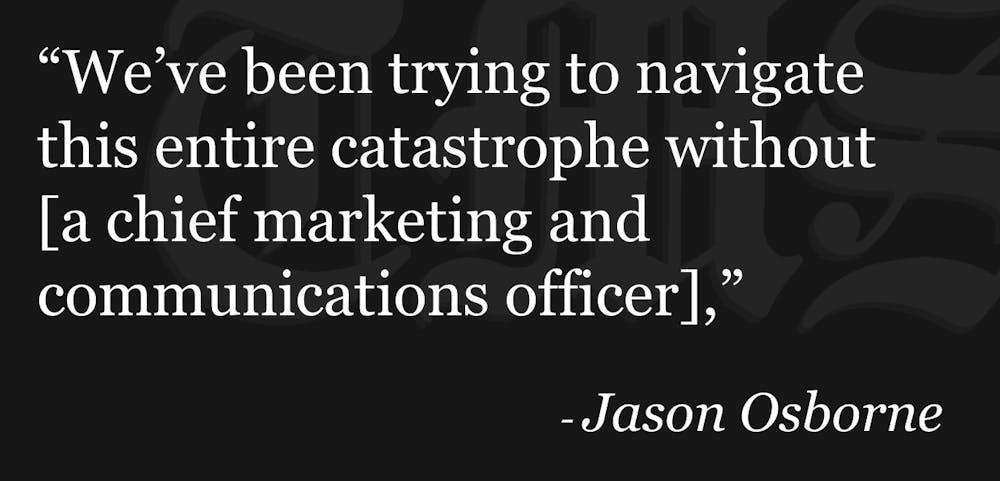When Miami University President Greg Crawford announced the return of residential students and face-to-face classes in a Sept. 9 email, he started a trend of conflicting messages about the state of the COVID-19 pandemic on Miami’s Oxford campus.
“This decision … is an expression of confidence in our campus community,” Crawford wrote.
Despite that confidence, by that point more than 1,000 students had already tested positive for COVID-19.
“[The university’s testing policy,]” Crawford wrote, “gives us the ability to quickly quarantine and isolate those who tested positive or those in close contact with individuals who tested positive.”
Now, it can sometimes take up to five days to “quickly quarantine” students after testing positive.
University administrators from President Crawford to the Crisis Management Team (CMT), which is without clear leadership, seemingly follow two general rules when updating students about COVID-19 at Miami:
First, they avoid providing students with numbers or data through email. Instead, they direct readers to a hard-to-navigate dashboard that omits information more than two weeks old.
Second, they don’t contextualize the pandemic in terms of the Miami-specific community. Instead, they opt for phrases like “The number of COVID-19 cases across our nation continues to rise,” as used in an Oct. 9 CMT email, or “Here in Butler County, the rate of positive cases continues to increase,” as Crawford wrote on Oct. 20.
Since the start of October, the CMT has sent four university-wide emails to students. While this group may feel anonymous to students — the CMT website offers no specific names for its members — Provost Jason Osborne explained that this anonymity allows for flexibility in responding to specific crises like COVID-19.
“[The CMT] is a lot of the university leadership,” Osborne said. “But then, it’s also everyone we need to pull in as well … It’s kind of one of these entities where everyone has representation and we can be experts depending on what the crisis is.”
Last February, Michelle Gaither Sparks, Miami’s chief marketing and communications officer, resigned, leaving the university without clear communications leadership heading into the pandemic.
“We’ve been trying to navigate this entire catastrophe without [a chief marketing and communications officer],” Osborne said. “We haven’t had one person waking up every day thinking about, ‘How do we strategically and effectively communicate in all the different ways we need to?’”
Enjoy what you're reading?
Signup for our newsletter
The university announced in July that Jaime Hunt would fill Sparks’ position effective Sept. 1. Hunt relocated from North Carolina in late August, and though she now works on campus, most of her staff is still remote.
Hunt explained that official university communications rarely come from a single administrator.
“Communications about COVID-19 … are developed in a collaborative process to ensure we have information and insights from multiple perspectives,” Hunt wrote in an email to The Miami Student.
Hunt also wrote that the decision to exclude numbers from emails regarding COVID-19 is intentional. Instead, the university relies on multiple streams to share information with students, including the COVID-19 dashboard, university social media accounts and signs across campus.
“Emails are just one way we share information about COVID-19 with the campus,” Hunt wrote. “The emails we send are not intended to duplicate the dashboard.”
This rule was followed without exception until Oct. 22, when the CMT included COVID-19 data in an email to students for the first time this semester.
“We are pleased to share that the seven-day average for positive COVID-19 cases on campus has dropped to 14.3 compared to 35.7 last week,” the CMT wrote.
To understand why data was included, it helps to look at another trend in university communications. Regardless of the sender, emails regarding COVID-19 often include lines like “Thank you for all you are doing to slow the spread of COVID-19 in the residential community,” as written in an Office of Residence Life email on Oct. 8.
“[W]hile not all students are following the guidelines, a great number are,” Hunt wrote. “Those who are following them deserve to be recognized for doing their part to slow the spread of the virus.”
For Osborne, it’s important to recognize positive trends in spite of the more than 2,000 student cases of COVID-19 this semester.
“We can’t just keep beating up everybody when I think the majority of folks are doing the right thing, or trying to,” Osborne said. “If you just get mired in all the negativity, you can lose sight of all the great things that are happening.”




